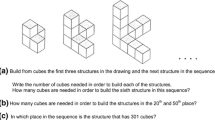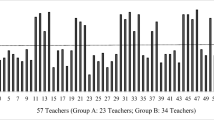Abstract
A developing body of research in classroom mathematics discourse indicates that teacher facilitation can be specific and supportive without interfering in productive student talk. Students, including those who are struggling in mathematics or lack confidence, can benefit from exploring challenging mathematics and engaging in math-talk. In this study, one teacher videotaped two academically struggling Grade 1 students engaged in a mathematical debate. Transcript analysis illustrated that the student pair used math-talk guidelines to explain their thinking and ask one another clarifying questions, gaining a deeper understanding of equivalent fractions in the process.
Résumé
Un nombre croissant de recherches sur le discours mathématique en classe indiquent que l’intervention des enseignants peut être à la fois spécifique et favorable, sans pour autant entraver le discours productif des élèves. Les élèves, y compris ceux qui éprouvent des difficultés en mathématiques ou qui manquent de confiance en eux dans ce domaine, peuvent tirer avantage d’activités servant à explorer certaines idées mathématiques et à en discuter. Dans cette étude, un enseignant a filmé deux élèves de première année ayant des difficultés en mathématiques, au cours d’un débat sur une question mathématique. Une analyse des transcriptions montre que les deux élèves se sont servis des Directives sur le discours mathématique pour illustrer leur pensée et se poser l’un à l’autre des questions de clarification, ce qui leur a permis de mieux comprendre les équivalences de fractions.
Similar content being viewed by others
References
Ball, D. L. (1993). With an eye on the mathematical horizon: Dilemmas of teaching elementary school mathematics. Elementary School Journal, 94(4), 373–397.
Bandura, A. (1986). Social foundations of thought and action: A social cognitive theory. Englewood Cliffs, NJ: Prentice Hall.
Baxter, J., Woodward, J., & Olson, D. (2001). Effects of reform-based mathematics instruction on low achievers in five third-grade classrooms. The Elementary School Journal, 101, 529–547.
Bochicchio, D., Cole, S., Ostien, D., Rodriguez, V., Staples, M., Susla, P., & Truxaw, M. (2009). Shared language. Mathematics Teacher, 102(8), 606–613.
Borasi, R. (1994). Capitalizing on errors as “springboards for inquiry”: A teaching experiment. Journal for Research in Mathematics Education, 25, 166–208.
Bruce, C. (2007). Student interaction in the math classroom: Stealing ideas or building understanding? What Works: Research Into Practice, 1, 1–4.
Civil, M. (1998). Mathematical communication through small group discussions. In M. Bartolini-Bussi, A. Sierpinska, & H. Steinbrig (Eds.), Language and communication in the mathematics classroom (pp. 207–222). Reston, VA: National Council of Teachers of Mathematics.
Eggleton, P., & Moldavan, C. (2001). The value of mistakes. Mathematics Teaching in the Middle School, 7(1), 42–47.
Empson, S. B. (2003). Low-performing students and teaching fractions for understanding: An interactional analysis. Journal for Research in Mathematics Education, 34(4), 305–343.
Geary, D. (1994). Children’s mathematical development: Research and practical applications. Washington, DC: American Psychological Association.
Gould, P., Outhred, L., & Mitchelmore, M. (2006). One-third is three-quarters of one-half. In P. Grootenboer, R. Zevenbergen, & M. Chinnappan (Eds.), Identities, cultures, and learning spaces: Proceedings of the 29th annual conference of the Mathematics Education Research Group of Australasia, Canberra (pp. 262–269). Adelaide, Australia: MERGA.
Hellerstein, D. (1984, March). The slow, costly death of Mrs. K: An account of mores as well as money. Harper’s Magazine, 84–89. Retrieved from http://harpers.org/archive/1984/03/002521
Hufferd-Ackles, K., Fuson, K. C., & Gamoran-Sherin, M. (2004). Describing levels and components of a math-talk learning community. Journal of Research in Mathematics Education, 35(2), 81–116.
King, A. (2002). Structuring peer interaction to promote high-level cognitive processing. Theory Into Practice, 41(1), 33–40.
Kroesbergen, E. H., Van Luit, E. H., & Maas, C. J. M. (2004). Effectiveness of explicit and constructivist mathematics instruction for low-achieving students in The Netherlands. The Elementary School Journal, 104(3), 233–251.
Lampert, M. (2001). Teaching problems and the problems of teaching. New Haven, CT: Yale University Press.
Lewis, C., Perry, R., & Murata, A. (2006). How should research contribute to instructional improvement? The case of Lesson Study. Educational Researcher, 35(3), 3–14.
Lubienski, S. (2000). A clash of social class cultures? Students’ experiences in a discussion-intensive seventh-grade mathematics classroom. The Elementary School Journal, 100, 377–403.
Manouchehri, A., & Enderson, M. C. (1999). Promoting mathematical discourse: Learning from classroom examples. Mathematics Teaching in the Middle School, 4(4), 216–222.
Moss, J., & Case, R. (1999). Developing children’s understanding of the rational numbers: A new model and an experimental curriculum. Journal for Research in Mathematics Education, 30(2), 122–148.
National Council of Teachers of Mathematics, Commission on Teaching Standards for School Mathematics. (1991). Professional standards for teaching mathematics. Retrieved from http://www.fayar.net/east/teacher.web/math/Standards/previous/ProfStds/credits.htm
Radford, L. (2000a). Signs and meanings in students’ emergent algebraic thinking: A semiotic analysis. Educational Studies in Mathematics, 42, 237–268.
Radford, L. (2000b). Students’ processes of symbolizing in algebra. A semiotic analysis of the production of signs in generalizing tasks. In T. Nakahara & M. Koyama (Eds.), Proceedings of the 24th conference of the International Group for the Psychology of Mathematics Education (pp. 81–88). Hiroshima, Japan: Hiroshima University. Retrieved from http://www.laurentian.ca/educ/lradford/
Radford, L. (2003). Gestures, speech and the sprouting of signs. Mathematical Thinking and Learning, 5(1), 37–70.
Radford, L. (2005). Why do gestures matter? Gestures as semiotic means of objectification. In H. Chick & J. Vincent (Eds.), Proceedings of the 29th conference of the International Group for the Psychology of Mathematics Education (Vol. 1, pp. 143–145). University of Melbourne, Melbourne, Australia.
Ross, J., & Bruce, C. (2007). Professional development effects on teacher efficacy: Results of a randomized experiment. Journal of Educational Research, 101(1), 50–60.
Ross, J. A., Hogaboam-Gray, A., & Rolheiser, C. (2002). Self-evaluation in Grade 11 mathematics: Effects on achievement and student beliefs about ability. In D. McDougall (Ed.), OISE papers on mathematical education (pp. 71–86). Toronto, Canada: Ontario Institute for Studies in Education, University of Toronto.
Ross, J. A., Xu, Y. M., & Ford, J. P. (2008). The effects of standards-based mathematics teaching on low achieving Grade 7 and 8 mathematics students. School Science and Mathematic, 108(8), 362–380.
Rowe, S. (2004). Discourse in activity and activity in discourse. In R. Rogers (Ed.), An introduction to critical discourse analysis in education (pp. 79–96). Mahwah, NJ: Lawrence Erlbaum.
Shunk, D., & Pajares, F. (2001). The development of academic self efficacy. In A. Wigfield & J. Eccles (Eds.), Development of achievement motivation (pp. 16–32). San Diego, CA: Academic Press.
Small, M. (2005). PRIME (professional resources and instruction for mathematics educators), number and operations diagnostic tests. Toronto, ON, Toronto: Thomson Nelson.
Smith, M. S., Hughes, E. K., Engle, R. A., & Stein, M. K. (2009). Orchestrating discussions. Mathematics Teaching in the Middle School, 14(9), 548–556.
Staples, M. (2007). Supporting whole-class collaborative inquiry in a secondary mathematics classroom. Cognition and Instruction, 25(2-3), 161–217.
Staples, M., & Colonis, M. M. (2007). Making the most of mathematical discussions. Mathematics Teacher, 101(4), 257–261.
Stein, M. K., Engle, R. A., Smith, M. S., & Hughes, E. K. (2008). Orchestrating productive mathematical discussions: Five practices for helping teachers move beyond show and tell. Mathematical Thinking and Learning: An International Journal, 10(4), 313–340.
Tufte, E. R. (1990). Envisioning information. Cheshire, CT: Graphics Press.
Van Chloest, L. R., & Enyart, A. (1998). Discourse, of course: Encouraging genuine mathematical conversations. Mathematics Teaching in the Middle School, 4(3), 150–155.
Walshaw, M., & Anthony, G. (2008). The teacher’s role in classroom discourse: A review of recent reseaarch into mathematics classrooms. Review of Educational Research, 78(3), 516–551.
Woodward, J., & Brown, C. (2006). Meeting the curricular needs of academically low-achieving students in middle grade mathematics. The Journal of Special Education, 40(3), 151–159.
Yackel, E., & Cobb, P. (1996). Sociomathematical norms, argumentation, and autonomy in mathematics. Journal for Research in Mathematics Education, 27(4), 458–477.
Author information
Authors and Affiliations
Corresponding author
Rights and permissions
About this article
Cite this article
Bruce, C.D., Flynn, T. Which Is Greater: One Half or Two Fourths? An Examination of How Two Grade 1 Students Negotiate Meaning. Can J Sci Math Techn 11, 309–327 (2011). https://doi.org/10.1080/14926156.2011.570475
Published:
Issue Date:
DOI: https://doi.org/10.1080/14926156.2011.570475




